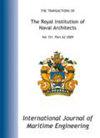使能技术与海军建筑师1860-2010
IF 0.6
4区 工程技术
Q4 ENGINEERING, MARINE
引用次数: 0
摘要
使能技术使海军建筑师能够用更少的资源做更多的事情,增加产量,降低成本,提高生产力,由此产生的利益在全球经济中广泛分布。例如,如今散货船每吨英里的能耗不到一个半世纪前的3%,这是由于更高效的机械、更大的船体、更低的每吨阻力和更高的推进效率,但速度更高、港口时间更短。本文章由计算机程序翻译,如有差异,请以英文原文为准。
ENABLING TECHNOLOGY AND THE NAVAL ARCHITECT 1860-2010
Enabling technology permits the naval architect to do more with fewer resources, increasing output, decreasing cost and improving productivity, with the resulting benefits being widely distributed in a worldwide economy. For example a bulk carrier’s energy consumption per ton-mile today is less than 3% of what it was a century and half ago – due to more efficient machinery, larger hulls with lower resistance per ton and improved propulsive efficiency, yet with higher speed and shorter port times.
求助全文
通过发布文献求助,成功后即可免费获取论文全文。
去求助
来源期刊

International Journal of Maritime Engineering
ENGINEERING, MARINE-
CiteScore
1.20
自引率
0.00%
发文量
18
审稿时长
>12 weeks
期刊介绍:
The International Journal of Maritime Engineering (IJME) provides a forum for the reporting and discussion on technical and scientific issues associated with the design and construction of commercial marine vessels . Contributions in the form of papers and notes, together with discussion on published papers are welcomed.
 求助内容:
求助内容: 应助结果提醒方式:
应助结果提醒方式:


